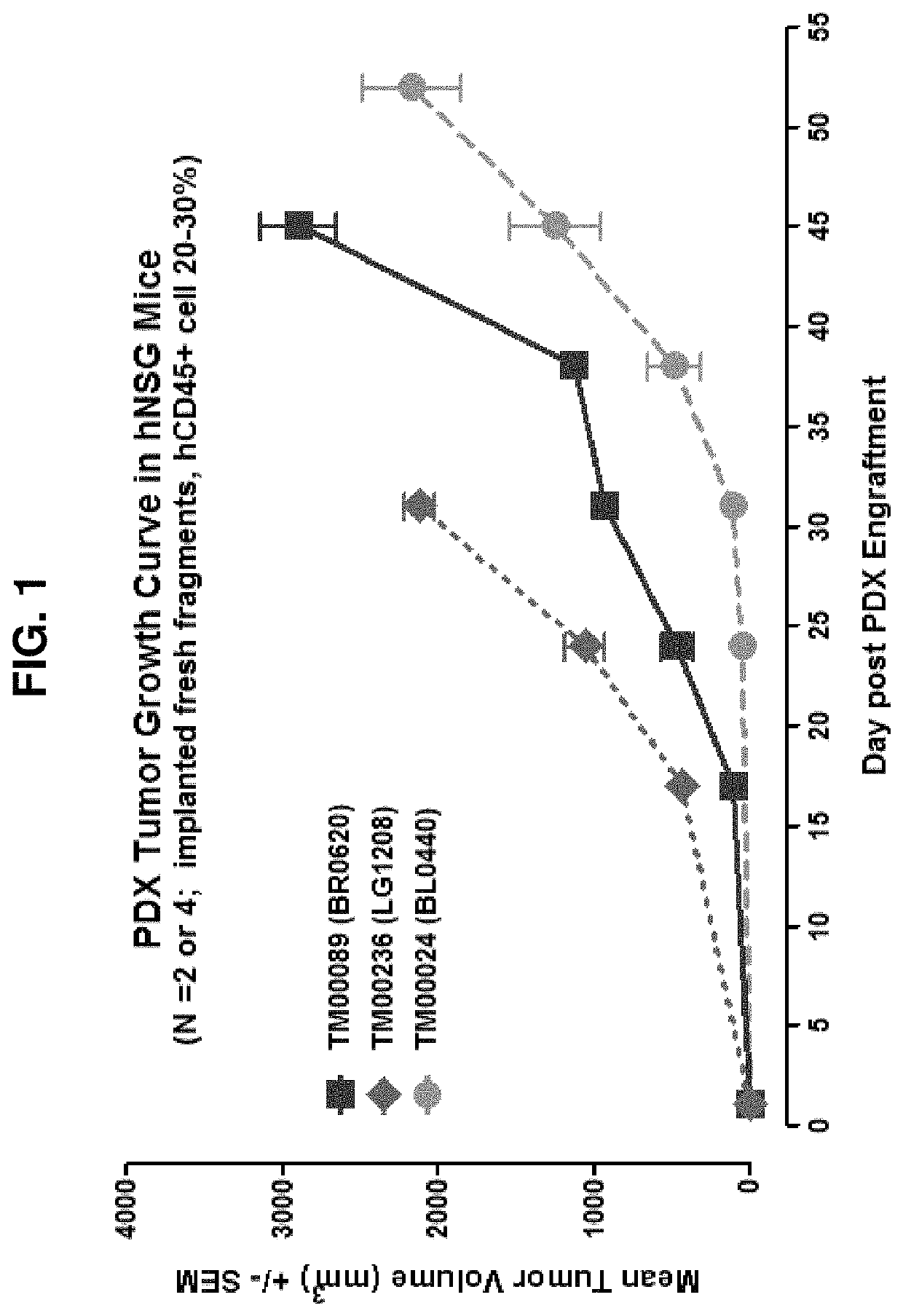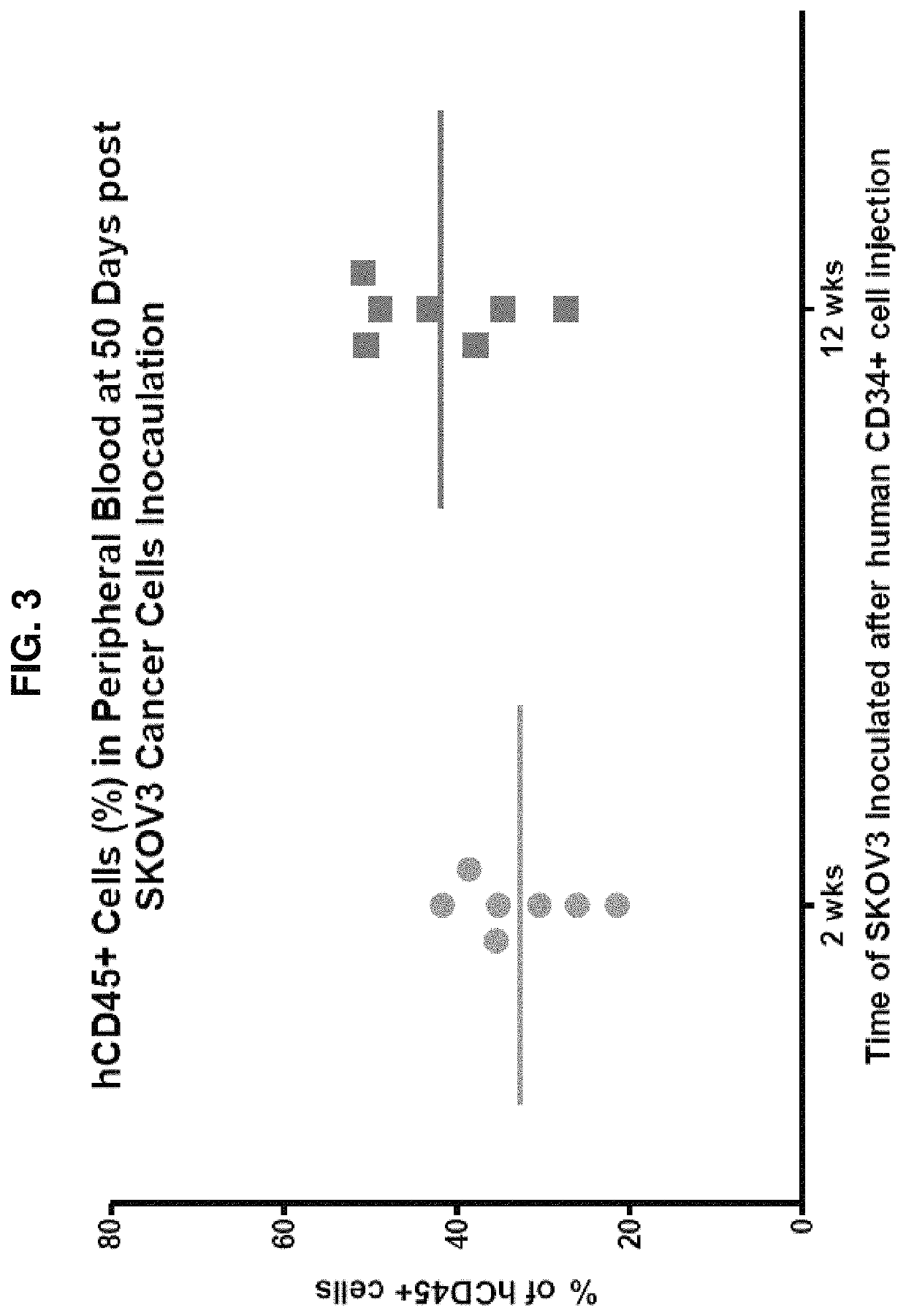Non-HLA matched humanized NSG mouse model with patient-derived xenograft
a mouse model and mouse technology, applied in the field of non-hla matched humanized nsg mouse model with patient-derived xenograft, can solve the problems of difficult characterization and treatment of diseases and defects, complex immune system disorders of vertebrates, and difficult characterization of diseases and defects. to achieve the effect of enhancing tumor killing
- Summary
- Abstract
- Description
- Claims
- Application Information
AI Technical Summary
Benefits of technology
Problems solved by technology
Method used
Image
Examples
example 1
Mice
[0157]NOD.Cg-PrkdcscidIl2rgtml Wjl / SzJ (NOD-scid IL2rγnull, NSG) mice were obtained from colonies developed and maintained at The Jackson Laboratory (Bar Harbor, Me.). All animals were housed in a specific pathogen free facility, in microisolator cages, and given autoclaved food and maintained on sulfamethoxazole-trimethoprim medicated water (Goldline Laboratories, Ft. Lauderdale, Fla.) and acidified autoclaved water on alternating weeks.
example 2
Engraftment of Mice with Human Hematopoietic Stem Cells (HSCs)
[0158]Groups of 24 to 72 hour-old (newborn) NSG mice are irradiated with 100 cGy as described in Pearson et al. (Curr. Protoc. Immunol. 81:15.21.1-15.21.21, 2008). Irradiated mice are injected with CD3 T cell-depleted human umbilical cord blood (UCB) containing 3×104 CD34+ hematopoietic stem cells (HSC) in a 25-50 μL volume via intracardiac injection as described in Brehm et al. (Clinic. Immunol. 135(1):84-98, 2010). After 12 weeks, flow cytometry analyses of the blood of HSC recipients quantifies the engraftment of the human immune system. For experimental studies only mice with >20% peripheral human CD45+ cells and >5% human CD3+ T cells are used.
[0159]Similarly, sub-lethally irradiated newborn NSG mice can also be injected with CD3 T cell-depleted human umbilical cord blood (UCB) containing 3×104 CD34+ hematopoietic stem cells (HSC) via intrahepatic injection or through facial vein injection as described in Brehm et al...
example 3
Recapitulation of Expected PDX Growth Rates does not Require HLA-Type Matching
[0164]Humanization of the NSG mouse were performed substantially as described above in Example 2. Briefly, groups of about 3 weeks old NSG mice were subject to whole-body irradiation (about 200 cGy) before about 0.2-1×106 CD34+HSCs are injected via lateral tail vein using standard techniques. PDX xenografts using three different cancer samples (breast cancer cells BR0620, lung cancer cells LG1208, and bladder cancer cells BL0440) were implanted subcutaneously into a subject humanized NSG mouse model—i.e., hu-CD34 NSG mice with established and functionally mature human immune cells derived from an HLAmismatched human HSC donor, and the growth of the PDX engraftments were monitored for up to about 55 days post PDX engraftment. All three tumors showed robust growth and no obvious indication of rejection (FIG. 1).
[0165]The results show that HLA-type matching is not required to recapitulate expected PDX growth ...
PUM
| Property | Measurement | Unit |
|---|---|---|
| periods of time | aaaaa | aaaaa |
| volume | aaaaa | aaaaa |
| time | aaaaa | aaaaa |
Abstract
Description
Claims
Application Information
 Login to View More
Login to View More - R&D
- Intellectual Property
- Life Sciences
- Materials
- Tech Scout
- Unparalleled Data Quality
- Higher Quality Content
- 60% Fewer Hallucinations
Browse by: Latest US Patents, China's latest patents, Technical Efficacy Thesaurus, Application Domain, Technology Topic, Popular Technical Reports.
© 2025 PatSnap. All rights reserved.Legal|Privacy policy|Modern Slavery Act Transparency Statement|Sitemap|About US| Contact US: help@patsnap.com



